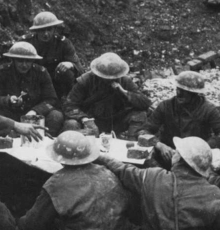Christmas in the trenches through the lens of historians

Christmas in the trenches during the Great War
A soldier’s life during war can be quite difficult. During the First World War it was outright awful.
Soldiers had to spend hours crouched in trenches and lived in constant fear for their lives. They were cold, wet and covered with mud. Exhausted by endless sleepless nights and days, they lived in unsanitary conditions that helped infectious diseases, such as dysentery, cholera and typhoid fever, spread rapidly. Constant exposure to wetness caused trench foot, a painful condition where dead tissue spreads across the foot, sometimes requiring amputation.
To satiate their hunger, soldiers relied mostly on stale biscuits, jam, and corned beef, at least those serving in the British army. For the German troops, a day’s ration consisted of some army bread, poor-quality black coffee, the odd bit of sliced sausage, jam, and a sort of grey lard which the soldiers called Hindenburg - or monkey-fat.
Making the most of it
During calm periods on the front, soldiers had to fight another enemy: boredom. They tackled it in various ways. One of the simplest soldier pastimes was gambling through card playing. When out of the front line, there was a bit more freedom: the troops would play football or spent their free time at Estaminets – small cafés run by civilians – where they’d buy themselves a meal and a drink.
The lecture
Through letters, diaries and memoirs of British soldiers, the lecture will shed light on the troop experiences of Christmas during the Great War. The lecturer, Alan Wakefield, will examine four key themes: Fraternization with the enemy, food and drink, entertainment and contact with civilians. The examples come from soldiers serving, between 1914 and 1918, in the Western Front, the Balkans, Italy and the Middle East.
The lecture, part of the House of European History’s series Through the lens of..., will be moderated from the museum’s Eastman building with limited onsite participation due to Covid-19 restrictions. There are no limits to online participation. A debate will follow the lecture.
------------------------------------------------
Alan Wakefield is Head of First World War & Early 20th Century Conflict at Imperial War Museums, where he leads the curatorial team charged with interpreting and developing the collection of material covering the period 1900 – 1929. He is a recognised authority on British involvement in the Salonika Campaign (1915-1918) and has lectured and contributed to publications in the UK, Greece, Russia and Serbia on aspects of the campaign and other First World War related subjects.
Moderation by Chris Burns, Franco-American journalist and media expert with more than 30 years' reporting experience in Europe, the U.S., Africa, Central Asia and the Middle East, will moderate the event.
Introduction by Kieran Burns, curator at the House of European History.
Image credit: British soldiers eating their Christmas dinner in a shell hole near Beaumont Hamel on the Somme battlefield, 25 December 1916. (Imperial War Museums - Q 1631)








